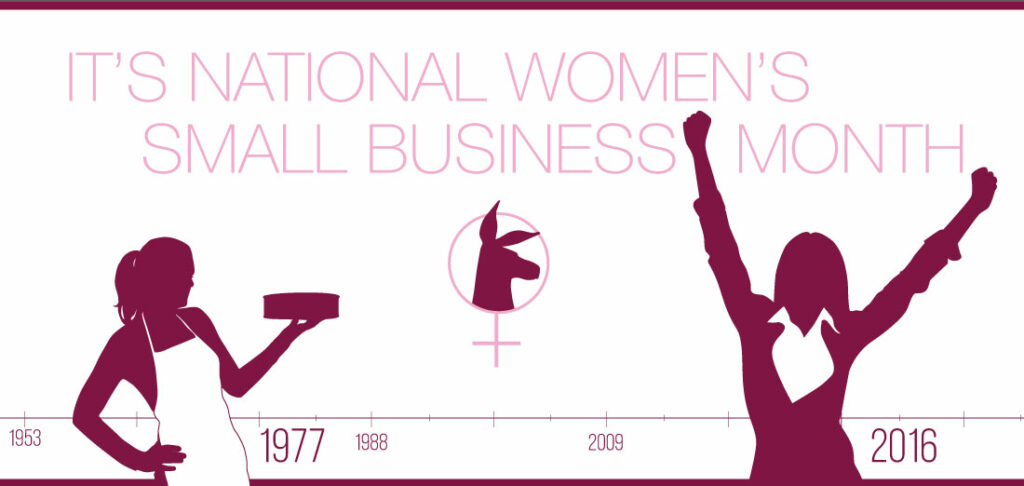October is Women’s Small Business Month. And as a Small Business started by a (you guessed it) woman, well we celebrate all it takes to be successful and make your mark as a small business. When we look at women entrepreneurs today, there are more than 9.8 million women-owned businesses in the United States. But it hasn’t been this way for all that long. We are starting out #NWSBM with a look back at the women who paved the way in business and are kicking butt.
1857
A Women’s Work
The Times in its editorial of 11 February 1857 opined ‘It is a terrible incident of our social existence that the resources for gaining a livelihood left open to women are so few. … At present, the language practically held by modern society to destitute women may be resolved into “Marry – Stitch – Die – or Do worse!”
1880s-1920s
Shopgirl
For the most part, women found jobs as “helpmates” of various types. They worked as laborers in workshops and factories, as clerks in burgeoning bureaucracies, and as salesgirls or departmental supervisors in retailing establishments, including urban department stores.
1904
Madame C.J. Walker
In 1904, Walker had been selling hair products for Annie Turnbo Malone, an African American hair-care entrepreneur herself. Walker used every minute of her time with Malone to eventually develop her own product line. She eventually became the first female self-made millionare in the US
1972
It’s a Start
Women owned just 4 percent of all American businesses
1954
Brownie Wise, a pioneering saleswoman and business leader responsible for the success of the Tupperware Party was the first woman to appear on the cover of Business Week.
1963
Equal Pay Act
Passed in 1963, a United States labor law amending the Fair Labor Standards Act, aimed at abolishing wage disparity based on sex (see Gender pay gap). Today, according to the Washington Post, women earn only 79 percent of men’s average hourly wages. There’s a long way to go.
In 1973
Room to Grow
Katharine Graham was THE ONLY female CEO of a Fortune 500 company.
https://www.allbusinessschools.com/business-administration/women-in-business/
1977
Sweet Entrepreneurship
Debbi Fields, a young mother with no business experience whatsoever, opened her first cookie store in Palo Alto, California, in 1977. At the age of 20, Fields was able to persuade a bank to finance Mrs. Fields Chocolate Chippery. Despite critics, she garnered worldwide acceptance as the premier chain of cookies and baked goods.
1988
Women’s Business Ownership Act
The Act was created to address the needs of women in business by giving women entrepreneurs better recognition, additional resources, and by eliminating discriminatory lending practices by banks that favored male business owners over female. The bill was signed into law by President Ronald Reagan.
1991
Own it!
Women owned 38 percent of American Businesses vs. just 4 percent 20 years earlier.
2009
Women & ROI
Lloyd C. Blankfein, Chairman and CEO of Goldman Sachs, declared that women’s businesses offer the “highest return on investment.”
2013
The Kangaroo, she comes out swinging
WebPunch formed out of another company called Marketing Collaborative that formed in 2009. Ginger Jones (founder) noticed a need for reputation management. She saw that are clients were getting slammed online, but what was being said by clients in the way of internal feedback was positive. Out of this the Review Service WebPunch was born!
2014
Better access to Federal Contracts
women entrepreneurs from across the country packed a hearing of the Senate’s Small Business Committee to demand reforms aimed at increasing women-owned small businesses’ access to federal contracts, capital and business counseling.
2016
Startup Power
According to Inc.com, 18% of all startups today have at least one female founder (2015).
Ladies Making It
Tory Burch has created a fashion empire with $800 million in revenues generated because she identifies and sells exactly what women want. So has Sara Blakely, founder of SPANX, whose company has annual revenues of $250 million.
Have a story you want to share about a female taking the small business world by storm? We’d love to hear it!


